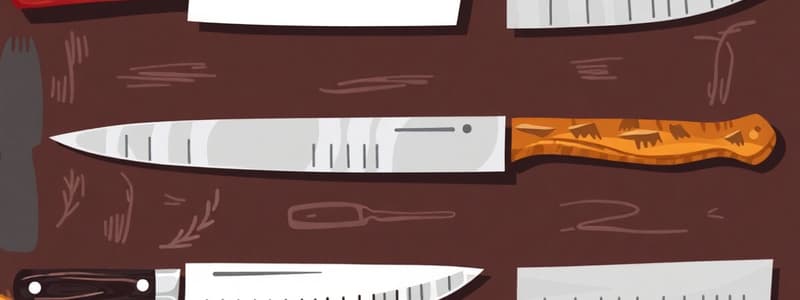Podcast
Questions and Answers
Which of the following is NOT considered a source of meat, according to the definition?
Which of the following is NOT considered a source of meat, according to the definition?
- Pigs
- Poultry (correct)
- Sheep
- Cattle
Mise en place primarily refers to the process of cooking the ingredients.
Mise en place primarily refers to the process of cooking the ingredients.
False (B)
What is the main purpose of a boning knife?
What is the main purpose of a boning knife?
- Cutting through bones
- Boning raw meats and poultry (correct)
- Slicing cooked meats
- Carving roast chicken and duck
The 'A-side' of beef carcass refers to one side of the carcass split through the ______.
The 'A-side' of beef carcass refers to one side of the carcass split through the ______.
Match the following types of knives with their primary uses:
Match the following types of knives with their primary uses:
Briefly explain the significance of 'marbling' in the context of meat composition, and list two qualities it enhances.
Briefly explain the significance of 'marbling' in the context of meat composition, and list two qualities it enhances.
Elastin is a connective tissue in meat that dissolves when cooked.
Elastin is a connective tissue in meat that dissolves when cooked.
What percentage of meat composition does water typically constitute?
What percentage of meat composition does water typically constitute?
The Maillard Reaction is the reaction between reducing the sugar and ______ by the impact of heat.
The Maillard Reaction is the reaction between reducing the sugar and ______ by the impact of heat.
Which of the following knives is best suited for accurately cutting steaks?
Which of the following knives is best suited for accurately cutting steaks?
Flashcards
Beef
Beef
Meat from cattle, typically over one year old.
Pork
Pork
Meat from domesticated pigs.
Lamb
Lamb
Meat from domesticated sheep, typically young.
Mise en place
Mise en place
Signup and view all the flashcards
Primal Cuts
Primal Cuts
Signup and view all the flashcards
French Knife / Chef's Knife
French Knife / Chef's Knife
Signup and view all the flashcards
Boning Knife
Boning Knife
Signup and view all the flashcards
Tenderness
Tenderness
Signup and view all the flashcards
Collagen
Collagen
Signup and view all the flashcards
Maillard Reaction
Maillard Reaction
Signup and view all the flashcards
Study Notes
- Meat refers to the flesh of cattle, sheep, and pigs.
- Meat is divided into large sections called "Primal Cuts".
Primal Cuts
- Primal Cuts are broken down further into individual steak and other retail cuts.
A-side
- A-side literally refers to one side of the beef carcass that is split through the backbone.
Mise en place
- Mise en place is a term used in professional kitchens
- It describes the organizing and arranging of the workspace, ingredients, and equipment before beginning to cook.
Types of Knives and Their Uses
- French Knife or Chef's Knife is for general purpose chopping, slicing, and dicing.
- Utility Knife is used for carving roast chicken and duck.
- Boning Knife is used for boning raw meats and poultry.
- Slicer is used for carving and slicing cooked meats.
- Butcher Knife is used for cutting, sectioning, and trimming raw meats in the butcher shop.
- Scimitar or Steak Knife is used for accurate cutting of steaks.
- Cleaver is used for cutting through bones.
Composition of Meat
- Water comprises 70% of muscle tissue.
- Protein comprises 20% of muscle tissue.
- Fat comprises 5% of muscle tissue.
Juiciness
- Juiciness in meat results from marbling, where fat is deposited within the muscle tissue.
Tenderness
- Tenderness in meat is achieved when marbling separates muscle fibers, making the meat easier to chew.
Flavor
- Flavor from meat comes primarily from fat.
Carbohydrates
- Carbohydrates play a role in the Maillard Reaction.
Maillard Reaction
- The Maillard Reaction is a complex reaction between reducing sugars and proteins caused by heat.
- Connective tissue is a network of proteins.
Types of Connective Tissue
- Collagen is a white connective tissue that dissolves.
- Elastin is a yellow connective tissue that does not break down.
Different Kinds of Meats and Their Source
- Pork comes from domesticated pigs and is typically fat and comes form younger animals (7-12 months).
- Beef comes from cattle over one year old (beef flesh of ox, bull, or cow).
- Lamb comes from domesticated sheep (meat from young sheep).
- Carabeef comes from carabao (meat from water buffalo or carabao).
- Chevon comes from deer/goat.
- Veal comes from a young calf, 4-5 months old.
Studying That Suits You
Use AI to generate personalized quizzes and flashcards to suit your learning preferences.




